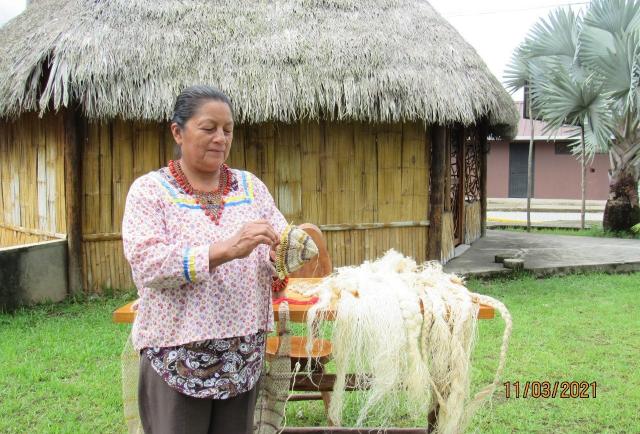With agility, at 80 years old, Yolanda Ramos moves her hands and weaves what will be one of her crafts that will be exhibited in the Sacha Maki project that the Municipality of the Aguarico canton, Orellana province, promotes to promote the work of various artisans in this town.
Yarcuviña, a city of stone unearthed
–
Read more
–
Daysi Chiguango, another of the artisans, intertwine the fiber with a small and thin cane wood (splinter), and thus crosses the threads to shape a bag.
Both women are part of a group of 34 artisans who participate in the Sacha Maki plan, which means hands of the jungle, with which the community members are allowed to spread their traditional activities and help each other in the sustenance of their families.
“The objective is to be able to promote and promote everything that is made within the canton and thus try to promote culture and to highlight the artisan hand that has been elaborated in an ancestral way for decades ”, said Juan Carlos Orellana, mayor of the Aguarico canton and president of Regional 2 of AME.
He further said, is a center where tourists who come to the municipal building to exchange their documents have been attracted, It is where the Merchant Navy or dock is located and in this way to commercialize the art of the Amazon fabric.
The hut is made of chonta, guadúa cane, toquilla leaves and liana. The size is 4 x 3 meters, located diagonally to the municipality.
According to Ramos, who belongs to the Bello Horizonte commune of the Nuevo Rocafuerte parish, She dedicated herself to this trade that she learned from her mother since she was little and now as part of this project she does not miss the opportunity to show what she is capable of doing. She prefers to weave at night, because during the day she is dedicated to raising her domestic animals and the resources obtained from the commercialization of her fabrics are used for her expenses and to buy medicines.
The artisan Daysi Chiguango She is grateful that through this program she can more easily sell her crafts and in this way it helps to maintain its home and the study of its children.
The artisans make bracelets, necklaces, chokers, lanzas, shigras (backpacks or bags), keychain earrings, carved raft decorations for desks, hammocks, nets, clothing and other items that are then left to be sold.
To execute the project they have adapted a cabin, In the Amazonian style, with the typical material of the ancestral huts, where the works of the group of artisans are exhibited.
The creations can be exhibited for a month. Those that are not marketed during that time are replaced by others. The artisans display their handicrafts to be sold under a brand called “Art made with hands.” In this way, they generate self-employment through the execution of an environmentally friendly economic development proposal.
The fruits of the chambira are coquitos similar to coconuts, From the tender shoots of the palm tree they extract the palm heart, they use it in typical dishes of the town. When the fruit is ripe it is used in handicrafts.
Process fiber and use of seeds
Some of the work is done with the fiber that is extracted from the chambira palm, a medicinal plant similar to that of the bouquets used during Holy Week. The comuneras harvest this fiber while it is tender, to turn it into the raw material with which they hand-weave their products. They detach the elongated leaves, then cut into threads to wash it and then simmer for five minutes in a large pot. This procedure helps make the fiber strong and resistant. In addition, for the decoration of their bracelets and necklaces, the artisans use huayruro seeds, which they also treat to apply them in their striking designs.
– .


